2018 MERCEDES-BENZ S-CLASS SEDAN belt
[x] Cancel search: beltPage 38 of 562
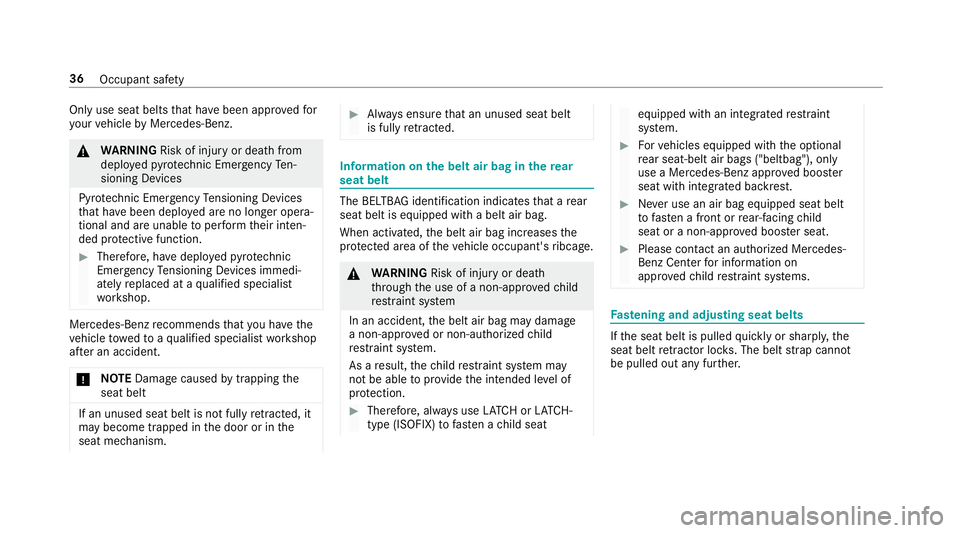
Only use seat beltsthat ha vebeen appr ovedfo r
yo ur vehicle byMercedes-Benz.
&
WARNING Risk of injury or death from
deplo yedpy rotech nic Emergency Ten‐
sioning Devices
Pyro tech nic Emergency Tensioning Devices
th at ha vebeen deplo yed are no longer opera‐
tional and are unable toper form their inten‐
ded pr otective function.
#Therefore, ha vedeplo yedpy rotech nic
Emergency Tensioning Devices immedi‐
ately replaced at a qualified specialist
wo rkshop.
Mercedes-Benz recommends that you ha vethe
ve hicle towe dto aqu alified specialist workshop
af te r an accident.
* NO
TEDama gecaused bytrapping the
seat belt
If an unused seat belt is not fully retracted, it
may become trapped in the door or in the
seat mechanism.
#Alw ays ensure that an unused seat belt
is fully retracted.
In fo rm ation on the belt air bag in there ar
seat belt
The BELTB AGidentification indicates that a rear
seat belt is equipped with a belt air bag.
When activated, the belt air bag increases the
pr otected area of theve hicle occupant's ribcage.
&
WARNING Risk of injury or death
th ro ugh the use of a non-appr ovedch ild
re stra int sy stem
In an accident, the belt air bag may damage
a non-appr oved or non-authorized child
re stra int sy stem.
As a result, thech ild restra int sy stem may
not be able toprov ide the intended le vel of
pr otection.
#Therefore, alw ays use LATC H or LATC H-
type (ISOFIX) tofast en a child seat
equipped with an integrated restra int
sy stem.
#Fo rve hicles equipped with the optional
re ar seat-belt air bags ("beltbag"), only
use a Mercedes-Benz appr oved boos ter
seat with integrated backrest.
#Ne ver use an air bag equipped seat belt
to fast en a front or rear-facing child
seat or a non-appr oved boos ter seat.
#Please contact an au thorized Mercedes-
Benz Center for information on
app rove dch ild restra int sy stems.
Fa stening and adju sting seat belts
Ifth e seat belt is pulled quickly or sharpl y,the
seat belt retractor lo cks. The belt stra p cann ot
be pulled out any fur ther.
36
Occupant saf ety
Page 39 of 562
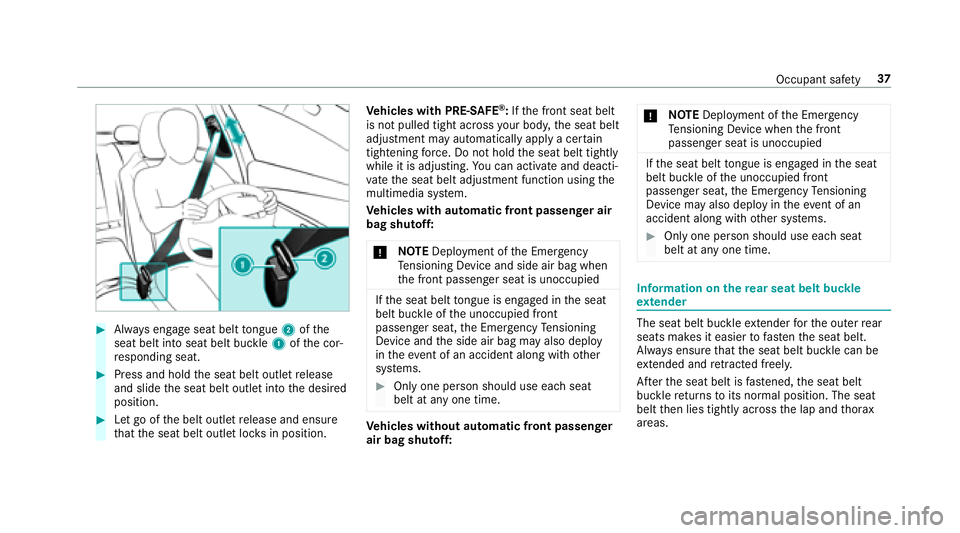
#Always engage seat belt tongue 2ofthe
seat belt into seat belt buckle 1ofthe cor‐
re sponding seat.
#Press and hold the seat belt outlet release
and slide the seat belt outlet into the desired
position.
#Let go of the belt outlet release and ensure
th at the seat belt outlet loc ksin position. Ve
hicles with PRE-SAFE
®:If th e front seat belt
is not pulled tight across your body, the seat belt
adjustment may automatically apply a cer tain
tigh tening forc e. Do not hold the seat belt tightly
while it is adjusting. You can activate and deacti‐
va te the seat belt adjustment function using the
multimedia sy stem.
Ve hicles with automatic front passenge r air
bag shu toff:
* NO
TEDeployment of the Emer gency
Te nsioning Device and side air bag when
th e front passenger seat is unoccupied
Ifth e seat belt tongue is engaged in the seat
belt buckle of the unoccupied front
passenger seat, the Emer gency Tensioning
Device and the side air bag may also deploy
in theev ent of an accident along with other
sy stems.
#Only one person should use each seat
belt at any one time.
Ve hicles without automatic front passenge r
air bag shu toff: *
NO
TEDeployment of the Emer gency
Te nsioning Device when the front
passenger seat is unoccupied
If th e seat belt tongue is engaged in the seat
belt buckle of the unoccupied front
passenger seat, the Emer gency Tensioning
Device may also depl oyintheev ent of an
accident along with other sy stems.
#Only one person should use each seat
belt at any one time.
Information on there ar seat belt buckle
ex tender
The seat belt buckle extender forth e outer rear
seats makes it easier tofast enthe seat belt.
Alw ays ensure that the seat belt buckle can be
ex tended and retracted freely.
Af terth e seat belt is fastened, the seat belt
buckle returns toits normal position. The seat
belt then lies tightly across the lap and thorax
areas.
Occupant saf ety 37
Page 40 of 562
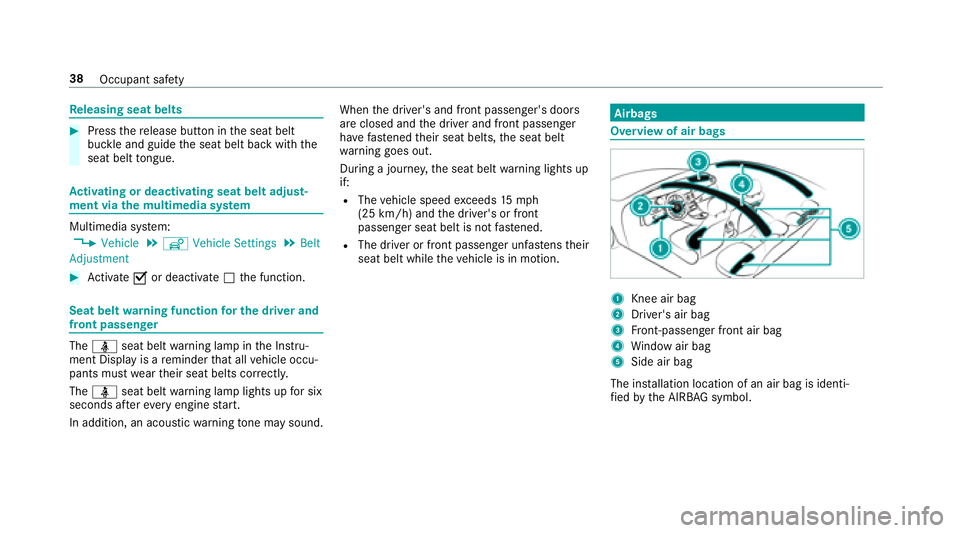
Releasing seat belts
#Press there lease button in the seat belt
buckle and guide the seat belt back with the
seat belt tongue.
Ac tivating or deactivating seat belt adjust‐
ment via the multimedia sy stem
Multimedia sy stem:
,�9�H�K�L�F�O�H.î �9�H�K�L�F�O�H �6�H�W�W�L�Q�J�V.�%�H�O�W
�$�G�M�X�V�W�P�H�Q�W
#Ac tivate Oor deacti vate ª the function.
Seat belt warning function for the driver and
front passen ger
The ü seat belt warning lamp in the Instru‐
ment Display is a reminder that all vehicle occu‐
pants must weartheir seat belts cor rectly.
The ü seat belt warning lamp lights up for six
seconds af tereve ryengine start.
In addition, an acoustic warning tone may sound. When
the driver's and front passenger's doors
are closed and the driver and front passenger
ha ve fast ened their seat belts, the seat belt
wa rning goes out.
During a journe y,the seat belt warning lights up
if:
RThe vehicle speed exceeds 15mp h
(25 km/h) and the driver's or front
passenger seat belt is not fastened.
RThe driver or front passenger unfas tens their
seat belt while theve hicle is in motion.
Airbags
Overview of air bags
1Knee air bag
2Driver's air bag
3Front-passenger front air bag
4Wi ndow air bag
5Side air bag
The ins tallation location of an air bag is identi‐
fi ed bythe AIRB AGsymbol.
38
Occupant saf ety
Page 41 of 562
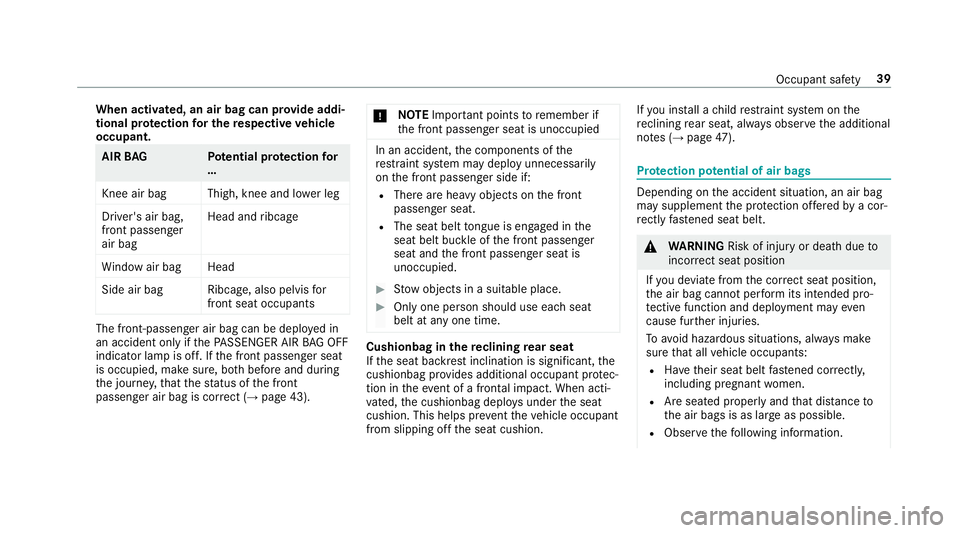
When activated, an air bag can provide addi‐
tional pr otection for the respective vehicle
occupant.
AIR BAGP otential pr otection for
…
Knee air bag Thigh, knee and lo wer leg
Driver's air bag,
front passenger
air bag Head and
ribcage
Wi ndow air ba gHead
Side air bag Ribcage, also pelvis for
front seat occupants
The front-passenger air bag can be deploy ed in
an accident only if thePA SSENGER AIR BAG OFF
indicator lamp is off. If the front passenger seat
is occupied, make sure, bo thbefore and during
th e journe y,that thest atus of the front
passenger air bag is cor rect (
→page 43). *
NO
TEImpo rtant points toremember if
th e front passenger seat is unoccupied
In an accident, the components of the
re stra int sy stem may deploy unnecessarily
on the front passenger side if:
RThere are heavy objects on the front
passenger seat.
RThe seat belt tongue is engaged in the
seat belt buckle of the front passenger
seat and the front passenger seat is
unoccupied.
#St ow objects in a suitable place.
#Only one person should use each seat
belt at any one time.
Cushionbag in there clining rear seat
If th e seat backrest inclination is significant, the
cushionbag pr ovides additional occupant pr otec‐
tion in theeve nt of a frontal impact. When acti‐
va ted, the cushionbag deplo ysunder the seat
cushion. This helps pr eventtheve hicle occupant
from slipping off the seat cushion. If
yo u ins tall a child restra int sy stem on the
re clining rear seat, alw ays obser vethe additional
no tes (
→page 47).
Protection po tential of air bags
Depending on the accident situation, an air bag
may supplement the pr otection of fere dby a cor‐
re ctly fastened seat belt.
&
WARNING Risk of injury or death dueto
incor rect seat position
If yo u deviate from the cor rect seat position,
th e air bag cann otper form its intended pro‐
te ctive function and deployment may even
cause fur ther injuries.
To avoid hazardous situations, alw ays make
sure that all vehicle occupants:
RHa ve their seat belt fastened cor rectly,
including pregnant women.
RAre seated proper lyand that dis tance to
th e air bags is as lar geas possible.
RObserv eth efo llowing information.
Occupant saf ety 39
Page 44 of 562
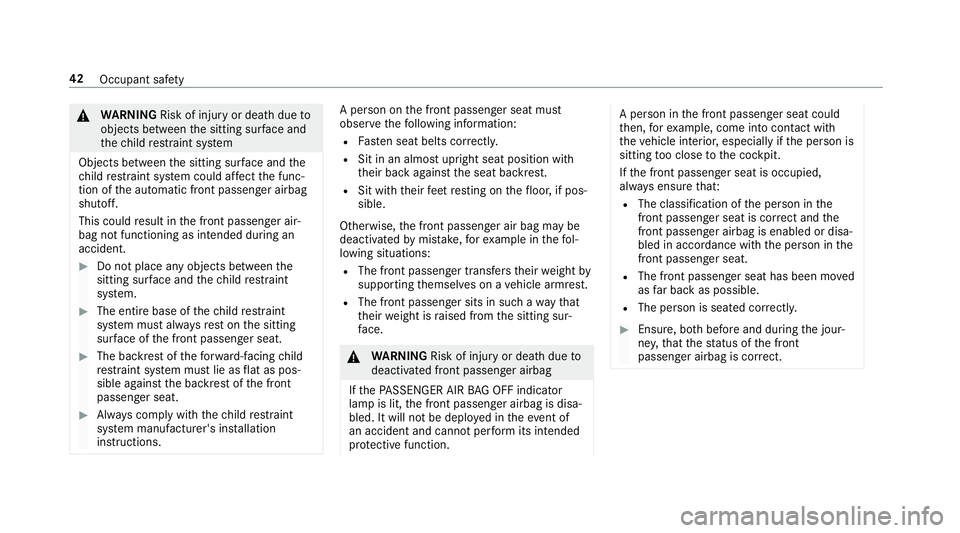
&WARNING Risk of injury or death dueto
objects between the sitting sur face and
th ech ild restra int sy stem
Objects between the sitting sur face and the
ch ild restra int sy stem could af fect the func‐
tion of the automatic front passenger airbag
shutoff.
This could result in the front passenger air‐
bag not functioning as intended during an
accident.
#Do not place any objects between the
sitting sur face and thech ild restra int
sy stem.
#The entire base of thech ild restra int
sy stem must alw aysre st on the sitting
sur face of the front passenger seat.
#The backrest of thefo rw ard-facing child
re stra int sy stem must lie as flat as pos‐
sible against the backrest of the front
passenger seat.
#Alw ays comply with thech ild restra int
sy stem manufacturer's ins tallation
instructions.
A person on the front passenger seat must
obser vethefo llowing information:
RFa sten seat belts cor rectl y.
RSit in an almost up right seat position with
th eir back against the seat backrest.
RSit with their feet resting on thefloor, if pos‐
sible.
Otherwise, the front passenger air bag may be
deactivated bymis take ,fo rex ample in thefo l‐
lowing situations:
RThe front passenge r transferstheir weight by
supporting themselves on a vehicle armrest.
RThe front passenger sits in such a wayth at
th eir weight is raised from the sitting sur‐
fa ce.
&
WARNING Risk of injury or death dueto
deactivated front passenger airbag
If th ePA SSENGER AIR BAG OFF indicator
lamp is lit, the front passenger airbag is disa‐
bled. It will not be deplo yed in theeve nt of
an accident and cannot pe rform its intended
pr otective function.
A person in the front passenger seat could
th en, forex ample, come into con tact wi th
th eve hicle interior, especially if the person is
sitting too close tothe cockpit.
If th e front passenger seat is occupied,
alw ays ensure that:
RThe classification of the person in the
front passenger seat is cor rect and the
front passenger airbag is enabled or disa‐
bled in accordance with the person in the
front passenger seat.
RThe front passenger seat has been mo ved
as far back as possible.
RThe person is seated cor rectl y.
#Ensure , bothbefore and during the jour‐
ne y,that thest atus of the front
passenger airbag is cor rect.
42
Occupant saf ety
Page 46 of 562

NEVER use arear wa rdfacing child restra int
on a seat pr otected byan ACTIVE FRONT AIR
BA G in front of it; DE ATH or SERIOUS INJU RY
to thech ild can occur.
When ins talling a child restra int sy stem on the
front passenger seat, observ eth eve hicle-spe‐
cific information in this Operator's Manual.
Depending on thech ild restra int sy stem and the
st ature of thech ild, thePA SSENGER AIR BAG
OFF indicator lamp may be off. In this case, do
not ins tallth ere ar wa rd-facing child restra int
sy stem on the front passenger seat.
Ins tead, ins tallth ere ar wa rd-facing child
re stra int sy stem on a suitable rear seat.
Af ter in stalling a forw ard-facing child
re stra int sy stem on the front passenger
seat: depending on thech ild restra int sy stem
and thest ature of thech ild, PASSENGER AIR
BA G OFF may be lit continuously or be off.
Alw ays obser vethefo llowing information.
&
WARNING Risk of injury or death dueto
incor rect positioning of thefo rw ard-
fa cing child restra int sy stem
If yo u secure a child in a forw ard-facing child
re stra int sy stem on the front passenger seat
and you position the front passenger seat too
close tothe cockpit, in theeve nt of an acci‐
dent, thech ild could:
RCome into con tact wi th theve hicle inte‐
ri or if thePA SSENGER AIR BAG OFF indi‐
cator lamp is lit, forex ample.
RBe stru ck bythe air bag if the
PA SSENGER AIR BAG OFF indicator lamp
is off.
#Alw ays mo vethe front passenger seat
as far back as possible and fully retract
th e seat cushion length adjustment.
Alw ays make sure that the shoulder belt
st ra p is cor rectly routed from the seat
belt outlet on theve hicle tothe shoul‐
der belt guide on thech ild restra int sys‐
te m. The shoulder belt stra p must be
ro uted forw ards and down wards from
th eve hicle belt outlet. If necessar y,
adjustthe seat belt outlet and the front
passenger seat accordingly.
#Alw ays obser vethech ild restra int sys‐
te m manufacturer's ins tallation instruc‐
tions.
When ins talling a child restra int sy stem on the
front passenger seat, observ eth eve hicle-spe‐
cific information in this Operator's Manual.
If a person is sitting in the front passenger
seat: PASSENGER AIR BAG OFF may be lit con‐
tinuously or be off, depending on the person's
st ature.
A person on the front passenger seat must
alw ays obser vethefo llowing information:
RIf th e front passenger seat is occupied with
an adult or a person with a stature cor re‐
sponding tothat of an adult, thePA SSENGER
AIR BAG OFF indicator lamp must be off. This
indicates that the front passenger air bag is
enabled.
If th ePA SSENGER AIR BAG OFF indicator
lamp is lit continuousl y,an adult or person
with a build cor responding tothat of an adult
44
Occupant saf ety
Page 47 of 562
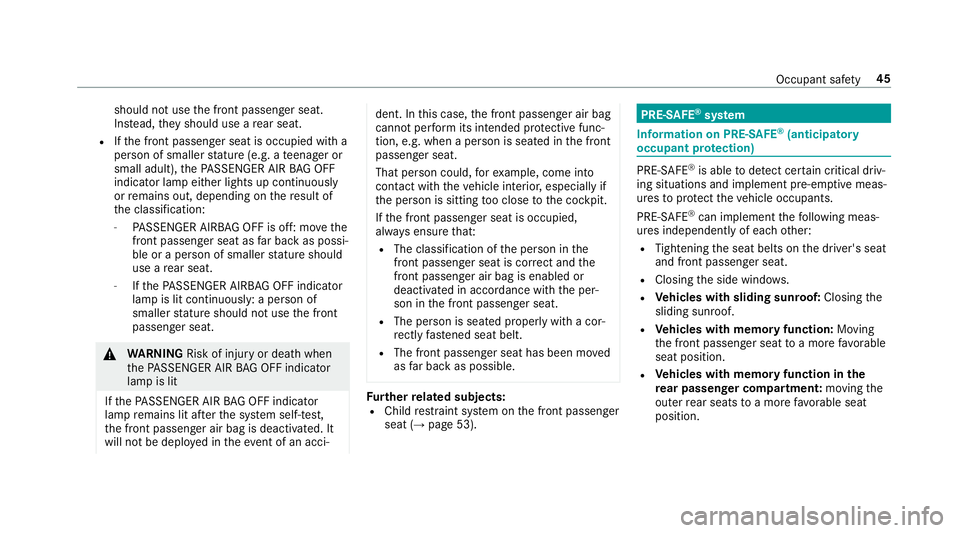
should not usethe front passenger seat.
Ins tead, they should use a rear seat.
RIfth e front passenger seat is occupied with a
person of smaller stature (e.g. a teenager or
small adult), thePA SSENGER AIR BAG OFF
indicator lamp either lights up continuously
or remains out, depending on there sult of
th e classification:
-PA SSENGER AIRB AGOFF is off: mo vethe
front passenger seat as far back as possi‐
ble or a person of smaller stature should
use a rear seat.
-Ifth ePA SSENGER AIRB AGOFF indicator
lamp is lit continuously: a person of
smaller stature should not use the front
passenger seat.
& WARNING Risk of injury or death when
th ePA SSENGER AIR BAG OFF indicator
lamp is lit
If th ePA SSENGER AIR BAG OFF indicator
lamp remains lit af terth e sy stem self-test,
th e front passenger air bag is deactivated. It
will not be deplo yed in theev ent of an acci‐
dent. In this case, the front passenger air bag
cannot perform its intended pr otective func‐
tion, e.g. when a person is seated in the front
passenger seat.
That person could, forex ample, come into
con tact wi th theve hicle interior, especially if
th e person is sitting too close tothe cockpit.
If th e front passenger seat is occupied,
alw ays ensure that:
RThe classification of the person in the
front passenger seat is cor rect and the
front passenger air bag is enabled or
deactivated in accordance with the per‐
son in the front passenger seat.
RThe person is seated proper lywith a cor‐
re ctly fastened seat belt.
RThe front passenger seat has been mo ved
as far back as possible.
Fu rther related subjects:RChild restra int sy stem on the front passenger
seat (→page 53).
PRE-SAFE®sy stem
Information on PRE- SAFE®(anticipa tory
occupant pr otection)
PRE- SAFE®is able todetect cer tain critical driv‐
ing situations and implement pre-em ptive meas‐
ures toprotect theve hicle occupants.
PRE-SAFE
®can implement thefo llowing meas‐
ures independently of each other:
RTightening the seat belts on the driver's seat
and front passenger seat.
RClosing the side windo ws.
RVehicles with sliding sunroof: Closingthe
sliding sunroof.
RVe hicles with memory function: Moving
th e front passenger seat toa more favo rable
seat position.
RVe hicles with memory function in the
re ar passenger co mpartment: movingthe
outer rear seats toa more favo rable seat
position.
Occupant saf ety 45
Page 48 of 562
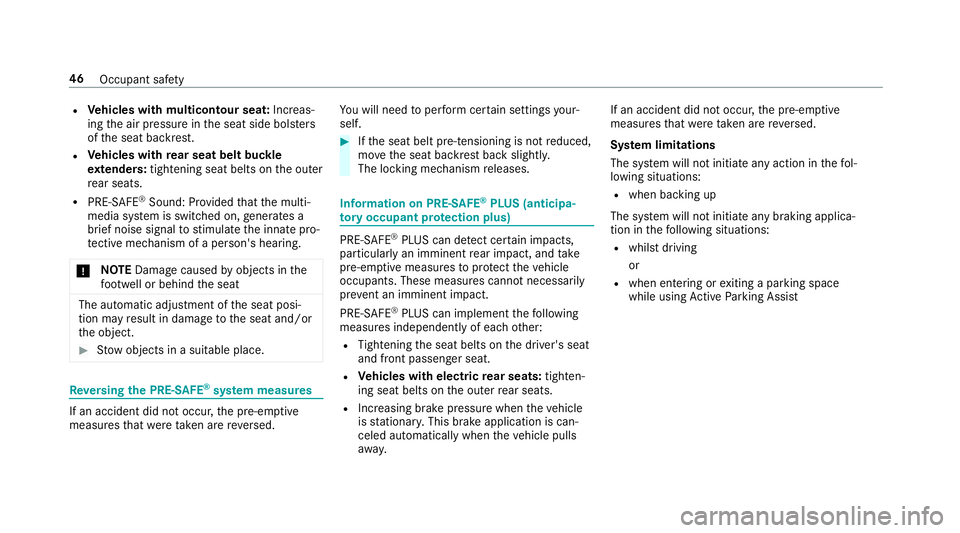
RVehicles with multicontour seat: Increas‐
ing the air pressure in the seat side bols ters
of the seat backrest.
RVe hicles with rear seat belt buckle
ex tenders: tightening seat belts on the outer
re ar seats.
RPRE- SAFE®Sound: Pr ovided that the multi‐
media sy stem is switched on, generates a
brief noise signal tostimulate the innate pro‐
te ctive mechanism of a person's heari ng.
* NO
TEDama gecaused byobjects in the
fo ot we ll or behind the seat
The automatic adjustment of the seat posi‐
tion may result in damage tothe seat and/or
th e object.
#St ow objects in a suitable place.
Reversing the PRE- SAFE®system measures
If an accident did not occur, the pre-em ptive
measures that we retak en are reve rsed. Yo
uwill need toper form certain settings your‐
self.
#If th e seat belt pre-tensioning is not reduced,
mo vethe seat backrest back slightl y.
The locking mechanism releases.
Information on PRE- SAFE®PLUS (anticipa‐
to ry occupant pr otection plus)
PRE- SAFE®PLUS can de tect cer tain impacts,
particular lyan imminent rear impact, and take
pre-em ptive measures toprotect theve hicle
occupants. These measures cannot necessarily
pr eve nt an imminent impact.
PRE-SAFE
®PLUS can implement thefo llowing
measures independently of each other:
RTightening the seat belts on the driver's seat
and front passenger seat.
RVe hicles with electric rear seats: tighten‐
ing seat belts on the outer rear seats.
RIncreasing brake pressure when theve hicle
is stationar y.This brake application is can‐
celed automatically when theve hicle pulls
aw ay. If an accident did not occur,
the pre-em ptive
measures that we retake n are reve rsed.
Sy stem limitations
The sy stem will not initiate any action in thefo l‐
lowing situations:
Rwhen backing up
The sy stem will not initiate any braking applica‐
tion in thefo llowing situations:
Rwhilst driving
or
Rwhen entering or exiting a parking space
while using Active Parking Assist
46
Occupant saf ety